Research - (2020) Advances in Dental Surgery
Correlation Between Diabetes and Completely Edentulous Condition-A Retrospective Study
Sagana M1, Revathi Duraisamy1* and Jeevitha M2
*Correspondence: Revathi Duraisamy, Department of Prosthodontics, Saveetha Dental College and Hospital, Saveetha Institute of Medical and Technical Sciences, Saveetha University, Chennai, India, Email:
Abstract
Diabetes mellitus is a disease of glucose, fat and protein metabolism resulting from impaired insulin secretion, varying degree of insulin resistance or both. Edentulism is a condition serving as a sign of constant oral and systemic disease process. It is known that the diabetes patients are prone to periodontal disease which is considered as the major reason for tooth loss. So, this study aims to correlate between the patients with diabetes and completely edentulous condition. A total of 392 patients with completely edentulous conditions were included in this study. Data was collected by reviewing patient records and by analysing the data of 86000 patients visited between June 2019 and March 2020. All the required data was recorded and analysed statistically by SPSS software using Chi Square test. From the analysis, it was found that the prevalence of completely edentulous condition was higher in Male patients. The incidence of completely edentulous condition with diabetes was 72%. There was a significant correlation (p<0.05) between diabetes and completely edentulous condition. From this study, we can conclude that the patients with diabetes were more prevalent to completely edentulous condition. Therefore, oral health care providers ought to create more awareness for diabetic patients with correct dental education.
Keywords
Glycemic control, Oral health, Systemic disease, Tooth loss
Introduction
Edentulism is a debilitating and irreversible condition and is represented as the final marker of disease burden for oral health [1]. Teeth contribute to the process of chewing, speech and maintaining facial aesthetics. Factors contributing to tooth loss embody socioeconomic status, education attainment, access to care and psychological state [2]. Edentulism directly affects facial appearance, nutrition, and the ability to eat, speak and socialize. In contrast to other chronic morbid conditions which will be amenable to therapeutic treatment, edentulism could be a definitive condition that is the endpoint of periodontitis and tooth decay [3- 5]. The comfort, function and esthetics must be restored altogether while treating a edentulous patients [6–9]. So, right dental treatment is required to hold good oral fitness [10]. The treatment for completely edentulous condition is complete removable prosthesis or fixed prosthesis supported by implants [11–14].
Though the prevalence of complete tooth loss has decreased over the last decade, edentulism remains a serious disease worldwide, particularly among adults [15,16]. However, there are intra and inter country variations in the prevalence of complete edentulism and direct comparison between national samples is tough because of the impact of varied factors like education, economic circumstances, lifestyle, oral health information, beliefs and attitude to dental care [17].
The consequences of periodontal disease and resulting tooth loss are not only necessary issues for the quality of life of patients, however they will also influence overall health by having an unhealthy diet and causing social disability. The presence of systemic conditions like diabetes, hypertension, cardiovascular disease, respiratory disease, and endocrine disorder can individually or collectively contribute to tooth loss [18,19].
Diabetes and its complications are one of the most significant and growing chronic health problems in the world. Diabetes mellitus is a clinical syndrome characterised by hyperglycemic because of absolute or relative deficiency of insulin [20]. Diabetes is a serious condition which predisposes to several conditions like cellulitis [21]. There are two general classes of diabetes: Type 1, results from an absolute insulin deficiency. Type 2, results of insulin resistance and an insulin secretory defect [22]. A study stated that aloe vera has its uses in diabetes [23].
Diabetes is more commonly found in dental patients. Patients with diabetes mellitus present with increased risk of infections with reduced salivary flow, low salivary buffering capacity and inadequate hygiene to complete dentures. Diabetes mellitus increases the susceptibility to erosion and ulceration of oral mucosa where it meets the base of complete denture [24,25]. Most complete dentures with diabetes reports with dry mouth and oral and functional symptoms [26,27].
The presence of plaque, periodontal disease seems to be related to severe pathological events associated with diabetes [28]. There is proof that management of periodontal infection in patients with poorly controlled diabetes may very well help improve glycemic control [29]. Tooth loss is an inevitable result of periodontitis [30]. By this, we can say that there is a relationship between tooth loss and diabetes. This study aims to correlate the relationship between the patients with completely edentulous condition and diabetes.
Materials and Methods
Data of patients with completely edentulous condition were collected by reviewing records of 86000 patients. Sample collected was from June 2019 to March 2020. A total sample data 392 of patients were included in this study. All the case sheets in Dental information archiving software were reviewed and cross verified with photographs. Approval from the ethical committee was taken before starting the study. The parameters that were collected are age, gender and presence or absence of diabetes. The patients with completely edentulous conditions were included in the study. Incomplete data were cross verified through phone calls to the patients and rejected data were excluded. All these data were entered in Microsoft excel sheet and analysed by SPSS software using Chi Square test.
Results and Discussion
Out of the total number of 392 completely edentulous patient’s data, it was found that 56% were male and 44% were female (Figure 1). The proportion of Male patients with completely edentulous conditions were higher than females. The incidence of completely edentulous patients with diabetes were found to be 72% and about 28% were found to be non-diabetic (Figure 2). About 67% of patients with completely edentulous condition were found between the age group of 50- 70 years. About 18% of patients with completely edentulous patients were found between the age group of 70-90 years and about 15% were between the age group of 30-50 years of age (Figure 3).
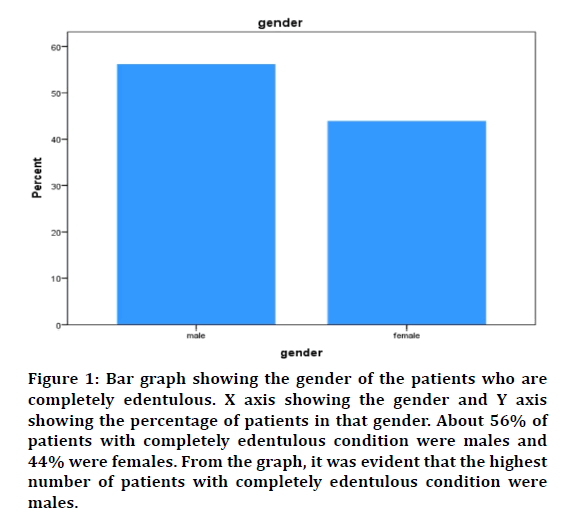
Figure 1: Bar graph showing the gender of the patients who are completely edentulous. X axis showing the gender and Y axis showing the percentage of patients in that gender. About 56% of patients with completely edentulous condition were males and 44% were females. From the graph, it was evident that the highest number of patients with completely edentulous condition were males.
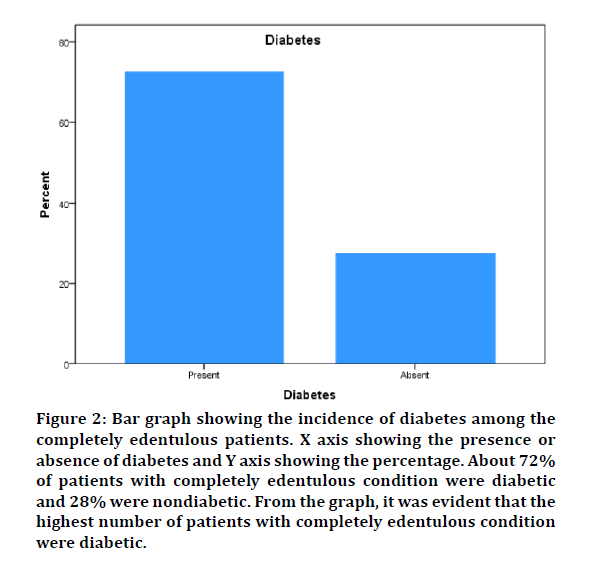
Figure 2: Bar graph showing the incidence of diabetes among the completely edentulous patients. X axis showing the presence or absence of diabetes and Y axis showing the percentage. About 72% of patients with completely edentulous condition were diabetic and 28% were nondiabetic. From the graph, it was evident that the highest number of patients with completely edentulous condition were diabetic.
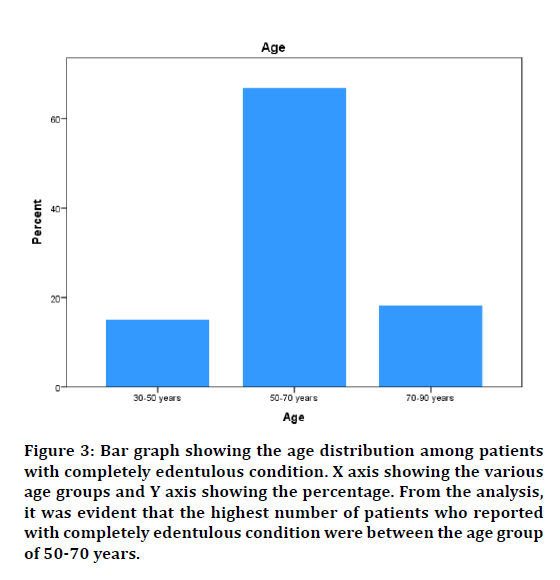
Figure 3: Bar graph showing the age distribution among patients with completely edentulous condition. X axis showing the various age groups and Y axis showing the percentage. From the analysis, it was evident that the highest number of patients who reported with completely edentulous condition were between the age group of 50-70 years.
Among the diabetic patients, 54% were found to be male and 46% were found to be female. About 75% of patients with diabetes were found between the age group of 50-70 years and 14% were found between the age group of 70-90 years of age and 11% were found between the age group of 30-50 years of age (Figures 4 and 5). According to the statistics, the p-value was found to be less than 0.05. Hence, there was a significant correlation between diabetes and completely edentulous condition.
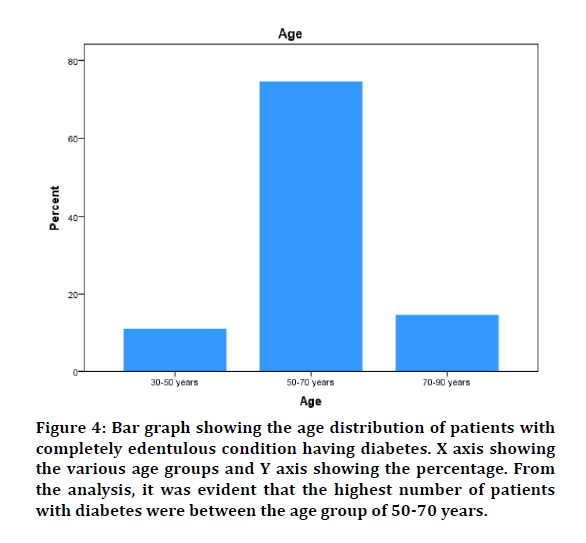
Figure 4: Bar graph showing the age distribution of patients with completely edentulous condition having diabetes. X axis showing the various age groups and Y axis showing the percentage. From the analysis, it was evident that the highest number of patients with diabetes were between the age group of 50-70 years.
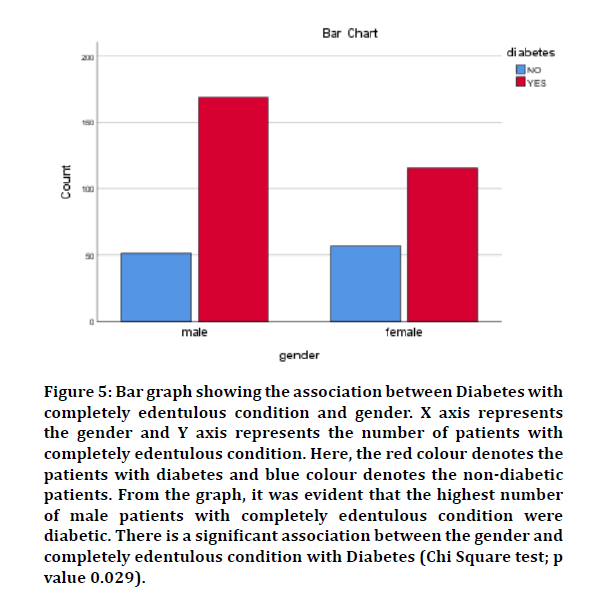
Figure 5: Bar graph showing the association between Diabetes with completely edentulous condition and gender. X axis represents the gender and Y axis represents the number of patients with completely edentulous condition. Here, the red colour denotes the patients with diabetes and blue colour denotes the non-diabetic patients. From the graph, it was evident that the highest number of male patients with completely edentulous condition were diabetic. There is a significant association between the gender and completely edentulous condition with Diabetes (Chi Square test; p value 0.029).
A study by Ladha, et al. [22] stated that there is a significant correlation between diabetes and edentulism. Our study finding states that there is a significant correlation between diabetes and completely edentulous condition. Hence, our study findings are in concordance with the literature. A study by Taboza et al. [31] stated that the edentulous patients presented with higher glycemic levels than the dental groups. Another study by Ikimi et al. [32] stated that the tooth loss is more in diabetic patients than non-diabetic patients. Results of our study are comparable with the results obtained from the literature.
A study by Moore et al. [33] have investigated the effects of insulin dependent diabetes and its correlation with tooth loss and have summarized that the duration of Type 1 diabetes is associated with tooth loss. This result correlates with our present study. A study by Emami et al. [17] stated the prevalence of completely edentulous condition is more common in age above 60 years. Results of our study (the most common age group is 50-70 years) is comparable with the results obtained from the present study. A study by Hosseini et al. [34] stated that about 55% of patients with completely edentulous condition were found to be male. The results of our study reported that 56% of patients with completely edentulous condition were found to be male. The results obtained from our study are like the results obtained from the literature. A study by Vijay et al. [35] stated that systemic disease, edentulism and nutrition are all interrelated. The results obtained from the present study are similar with the result obtained from the literature.
Limitations
The correlation between the completely edentulous condition and diabetes is observed with the fact that the subjects examined represent a selected population. Future studies can be done with larger sample sizes and in a varied population.
Conclusion
There is a significant correlation between diabetes and completely edentulous condition. So, Medical and dental professionals can improve patient management of oral and overall effects of diabetes by implementing numerous awareness programs regarding dental education and oral health promotion.
References
- Cunha-Cruz J, Hujoel PP, Nadanovsky P. Secular trends in socio-economic disparities in edentulism: USA, 1972–2001. J Dent Res 2007; 86:131–136.
- Singh DA. Correlation between edentulism, nutrition, and diabetes-An overview. J Med Sci Clin Res 2018; 6:624-627.
- Jyothi S, Robin PK, Ganapathy D, et al. Periodontal health status of three different groups wearing temporary partial denture. Vol. 10, Res J Pharma Technol 2017; 10:4339.
- Tyrovolas S, Koyanagi A, Panagiotakos DB, et al. Population prevalence of edentulism and its association with depression and self-rated health. Scientific Reports. 2016; 6:37083.
- Ganapathy D, Sathyamoorthy A, Ranganathan H, et al. Effect of resin bonded luting agents influencing marginal discrepancy in all ceramic complete veneer crowns. J Clin Diagn Res 2016; 10:67–70.
- Ariga P, Nallaswamy D, Jain AR, et al. Determination of correlation of width of maxillary anterior teeth using extraoral and intraoral factors in indian population: A systematic review. World J Dent 2018; 9:68–75.
- Selvan SR, Ganapathy D. Efficacy of fifth generation cephalosporins against methicillin-resistant Staphylococcus aureus-A review. Res J Pharma Technol 2016; 9:1815.
- Ashok V, Nallaswamy D, Benazir Begum S, et al. Lip bumper prosthesis for an acromegaly patient: A clinical report. J Indian Prosthodont Soc 2014; 14:279–282.
- Venugopalan S, Ariga P, Aggarwal P, et al. Magnetically retained silicone facial prosthesis. Nigerian J Clinical Practice. 2014; 17:260.
- Basha FYS, Ganapathy D, Venugopalan S. Oral hygiene status among pregnant women. Res J Pharma Technol 2018; 11:3099.
- Ganapathy DM, Kannan A, Venugopalan S. Effect of coated surfaces influencing screw loosening in implants: a systematic review and meta-analysis. World J Dent 2017; 8:496–502.
- Gallucci GO, Bernard JP, Belser UC. Treatment of completely edentulous patients with fixed implant-supported restorations: Three consecutive cases of simultaneous immediate loading in both maxilla and mandible. Int J Periodont Restorative Dent 2005; 25:27–37.
- Ajay R, Suma K, Ali SA, et al. Effect of surface modifications on the retention of cement-retained implant crowns under fatigue loads: An study. J Pharm Bioallied Sci 2017; 9:154–60.
- Duraisamy R, Krishnan CS, Ramasubramanian H, et al. Compatibility of nonoriginal abutments with implants. Implant Dent 2019; 28:289–295.
- Douglass CW, Shih A, Ostry L. Will there be a need for complete dentures in the United States in 2020? J Prosthet Dent 2002; 87:5–8.
- Kannan A, Venugopalan S. A systematic review on the effect of use of impregnated retraction cords on gingiva. Res J Pharma Technol 2018; 11:2121.
- Emami E, de Souza RF, Kabawat M, et al. The impact of edentulism on oral and general health. Int J Dent 2013; 2013:498305.
- Ong G. Periodontal disease and tooth loss. Int Dent J 1998; 48:233–238.
- Scannapieco FA, Papandonatos GD, Dunford RG. Associations between oral conditions and respiratory disease in a national sample survey population. Ann Periodontol 1998; 3:251–256.
- Koh D, Takahashi K. Textbook of occupational medicine practice. 2011.
- Vijayalakshmi B, Ganapathy D. Medical management of cellulitis. Res J Pharma Technol 2016; 9: 2067.
- Ladha K, Tiwari B. Type 2 Diabetes and edentulism as chronic co-morbid factors affecting indian elderly: An overview. J Indian Prosthodont Society 2013; 13:406–412.
- Subasree S, Murthykumar K, Dhanraj. Effect of aloe vera in oral health-A review. Res J Pharma Technol 2016; 9:609.
- Cristina de Lima D, Nakata GC, Balducci I, et al. Oral manifestations of diabetes mellitus in complete denture wearers. J Prosthet Dent 2008; 99:60–65.
- Ranganathan H, Ganapathy DM, Jain AR. Cervical and incisal marginal discrepancy in ceramic laminate veneering materials: A SEM analysis. Contemp Clin Dent 2017; 8:272–278.
- Ikebe K, Morii K, Kashiwagi J, et al. Impact of dry mouth on oral symptoms and function in removable denture wearers in Japan. Oral Surg Oral Med Oral Pathol Oral Radiol Endodont 2005; 99:704–710.
- Ashok V, Suvitha S. Awareness of all ceramic restoration in rural population. Res J Pharma Technol 2016; 9:1691.
- Ryan ME, Carnu O, Kamer A. The influence of diabetes on the periodontal tissues. J Am Dent Assoc 2003; 134:34S – 40S.
- Taylor GW. The effects of periodontal treatment on diabetes. J Am Dent Assoc 2003; 134:41S – 48S.
- Tervonen T, Karjalainen K. Periodontal disease related to diabetic status. A pilot study of the response to periodontal therapy in type 1 diabetes. J Clin Periodontol 1997; 24:505–510.
- Taboza ZA, Costa KL, Silveira VR, et al. Periodontitis, edentulism and glycemic control in patients with type 2 diabetes: A cross-sectional study. BMJ Open Diabetes Res Care 2018; 6:e000453.
- Ikimi NU, Sorunke ME, Onigbinde OO, et al. A study of the relationship between diabetes mellitus and tooth loss among diabetic patents in garki general hospital Garki Abuja, Fct Nigeria. Dentistry 2017; 7:2161-1122.
- Moore PA, Weyant RJ, Mongelluzzo MB, et al. Type 1 diabetes mellitus and oral health: assessment of tooth loss and edentulism. J Public Health Dent 1998; 58:135–142.
- Hosseini S, Bagheri A, Amani F, et al. Prevalence of complete edentulism and associated factors in Ardabil City, 2013. J Res Med Dent Scie 2015; 3:17-21.
- Anand MV, Vishnupriya R, Parvatham V. Is diabetes and cardiovascular disease a prevailing factor for edentulism. Int J Applied Dent Sci 2019; 5:82–85.
Author Info
Sagana M1, Revathi Duraisamy1* and Jeevitha M2
1Department of Prosthodontics, Saveetha Dental College and Hospital, Saveetha Institute of Medical and Technical Sciences, Saveetha University, Chennai, India2Department of Periodontics, Saveetha Dental College and Hospital, Saveetha Institute of Medical and Technical Sciences, Saveetha University, Chennai, India
Citation: Sagana M, Revathi Duraisamy, Jeevitha M,Correlation Between Diabetes and Completely Edentulous Condition-A Retrospective Study, J Res Med Dent Sci, 2020, 8 (7): 163-167.
Received: 27-Sep-2020 Accepted: 19-Oct-2020 Published: 26-Oct-2020
